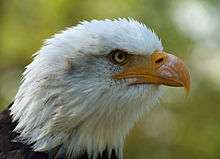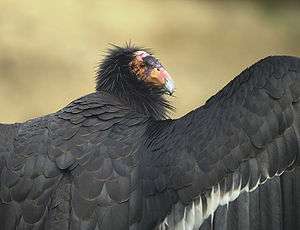Ventana Wildlife Society
| Non-profit | |
| Founded | 1977 |
| Headquarters | Salinas, California, United States.[1] |
Area served | Central Coast, California |
Key people | Kelly Sorenson (Executive Director) |
Number of employees |
8 full time and 8 seasonal 25 volunteers |
| Website | http://www.ventanaws.org |
Ventana Wildlife Society (VWS) is a 501(c)3 non-profit organization founded in 1977 by a group of private citizens to restore endangered species native to central California. VWS has three full-time staff biologists, together with seasonal interns, monitoring, tracking and researching endangered species, songbirds and butterflies. Educational science programs for school children - offered in a variety of Central Coast locations - bring youth in touch with nature in their own neighborhoods, or through summer science camps.
Mission
The mission of Ventana Wildlife Society is "Conserving Native Wildlife and Their Habitats". There are over 130 endangered species in California and many others that are threatened with extinction.[2]
Programs
VWS has four primary areas of focus:
- Species Recovery: endangered species, including the California condor and Bald eagle
- Conservation Ecology: research, assessment and monitoring of songbirds and Monarch butterflies
- Education and Outreach: environmental education
- Habitat Restoration: rebuilding of lost habitats.
History
In 1977, the Ventana Wildlife Society began by rehabilitating and releasing wildlife at a 240-acre (0.97 km2) remote site in the Ventana Wilderness.
1982: VWS introduced a Prairie and Peregrine falcon release program.

1986: VWS began a Bald eagle restoration project to reintroduce Bald eagles after an absence of 60 years from the region. In only 10 years, VWS achieved success.[3] In 2007, the Bald eagle was officially declared recovered and delisted[4] from the Endangered Species Act (ESA).
1992: The Ventana Wildlife Society Research and Education Center opened in Andrew Molera State Park, off scenic Highway 1, Big Sur. The primary purpose of this new facility is to increase public outreach efforts and to expand programs to include environmental education and habitat restoration.
1996: VWS was commended by the California State Senate for its distinguished record of serving the recovery needs of Central Coast endangered species and for instilling a sense of stewardship for the environment through direct educational experience.
1997: VWS joined federal and state efforts[5] to reintroduce the California condor and is the only non-profit releasing condors in California.
2009: VWS Discovery Center opened in Big Sur. The center currently features a special exhibition, "Bringing the Condors Home".
Species Recovery: California Condor Reintroduction Program

In 1987 the last of the wild free-flying condors was taken from the wild to become part of a captive breeding program. From a population perhaps numbering thousands across the U.S., the last surviving 27 birds were removed to prevent extirpation in California. Decades of shooting, environmental degradation and lead poisoning had reduced the population to an unviable number that most likely would not survive to the new millennium without this urgent, and at times controversial,[6] intervention.
In 1997, VWS began releasing captive-bred condors in Big Sur with great success and in 2003 initiated a second release site at Pinnacles National Monument (now Pinnacles National Park) in collaboration with the National Park Service.[7]
All of the free-flying birds are tagged and can be tracked via radio transmitter or GPS. VWS has created a website where one can learn more about the varied personalities of each of the birds of the Big Sur flock, and a blog where readers can follow the work of the biologists as they study the condors and monitor nests and condor chicks.
In 2007, the first condor chick hatched in the wild (in Monterey County) in 100 years.
At the end of 2007, the California Fish and Game Commission[8] voted to adopt regulations to restrict the use of lead bullets within the range of the California condor and to implement AB 821, legislation signed earlier that year.
In 2009, 42 condors were reported free-flying in central California.[9] With five chicks set to fledge, this was one of the best years for the Central Coast population. But California condors continue to be plagued with lead poisoning, micro-trash ingestion, and DDT residues, which all are seriously hampering the long-term recovery of the species.[10][11][12]
The Vallejo Times Herald (VTH) reported that in May 2014, California condor #597 (also known as "Lupine") was spotted near Pescadero, a coastal community south of San Francisco. This is the first California condor spotted in San Mateo County since 1904.[13] The three-year-old female flew more than 100 miles (160 km) north from Pinnacles National Park, in San Benito County, on May 30, and landed on a private, forested property near Pescadero, on the San Mateo County Coast, where it was photographed by a motion-activated wildlife camera.[13] Kelly Sorenson, executive director of the Ventana Wildlife Society, stated: "It's very important. It shows that they really are spreading out in their range. It's very exciting. It shows that we're on the right track. The population is expanding. They are breeding on their own. They are finding food on their own."[13]
By July 2014, the condor population, including sites in California, Baja California and Arizona, has grown to 437.[14] There is a population of 232 wild birds and 205 in captivity.[14] Ventana Wildlife Society manages 34 free-flying condors, of which it has fledged 9.[14]
References
- ↑ Audited Financial Statement: FY 2008
- ↑ U.S.Fish and Wildlife
- ↑ California Department of Fish and Game: Bald Eagles in California
- ↑ U.S. Fish and Wildlife Service: Bald Eagle Status
- ↑ California Condor Recovery Program
- ↑ Stanford University
- ↑ Pinnacles Condor Program
- ↑ California Fish and Game Commission: Condors and Lead
- ↑ Department of Fish & Game:Population Size and Distribution - Sept 2009
- ↑ L.A. Times
- ↑ American Ornithologists' Union
- ↑ Moir, John, "New Hurdle for California Condors May Be DDT From Years Ago", The New York Times, November 15, 2010. Retrieved 2010-11-15.
- 1 2 3 P. Rogers (14 June 2014). "First California condor spotted in San Mateo County since 1904". Vallejo Times Herald. Retrieved 28 August 2014.
- 1 2 3 "California Condor Recovery Program (monthly status report)" (PDF). National Park Service. 31 July 2014. Retrieved 31 August 2014.
External links
- Ventana Wildlife Society official site
- Condor Watch The Condor Watch crowdsourcing project, started April 2014.
- Get to Know Wild Condor Personalities
- Condor Stories from the Field